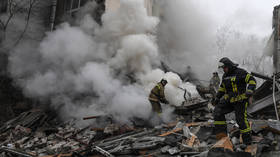Pentagon names winner of multibillion dollar stealth bomber contract

The Pentagon has awarded B-2 bomber producer Northrop Grumman with a lucrative contact to develop the next-generation of stealth bombers. The aerospace giant beat Boeing and Lockheed Martin after an intense four-year competition.
"Building this bomber is a strategic investment in the next 50 years, and represents our aggressive commitment to a strong and balanced force," Defense Secretary Ashton Carter said during a Pentagon briefing announcing the contract.
The long-awaited contract for the Long Range Strike Bomber, or LRS-B, is speculated to be one of the most lucrative in Air Force history.
Since the contract was announced, deal analysts estimated its value at between $60 billion to $80 billion if the US Air Force buys all 100 stealth bombers as planned. The LRS-B is expected to replace the B-52, of which there are currently 76 in operation, while 20 B-2s and 63 B-1Bs are in use.
Pentagon understated cost of new bomber by $25bn, blames ‘human error’ http://t.co/nazaZUlJPqpic.twitter.com/YHIej0tIkR
— RT America (@RT_America) September 1, 2015“The LRS-B is designed to replace the Air Force’s aging fleets of bombers – ranging in age from 50+ years for the B-52 to 17+ years for the B-2 – with a long range, highly survivable bomber capable of penetrating and operating in tomorrow’s anti-access, area denial environment,” Air Force Secretary Deborah Lee James said.
The aircraft will be designed to fly manned or unmanned while carrying both conventional and nuclear weapons.
“The LRS-B will provide our nation tremendous flexibility as a dual-capable bomber and the strategic agility to respond and adapt faster than our potential adversaries,” Gen. Mark A. Welsh III, Chief of Staff of the Air Force, said.
Based on a Pentagon estimate from 2010 – the latest regarding the Long Range Strike Bomber that did not take into account inflation – each plane will cost at least $550 million. A 2014 Congressional Research Service report put that figure at $810 million each.
On Tuesday, the Pentagon said that the contract is composed of two parts: One part is for the engineering and manufacturing development (EMD), and the second part would cover the delivery of 21 jets. The US government is ready to buy 100 aircraft.
READ MORE: What do we know about the Long Range Strike Bomber?
“Based on approved requirements, the Average Procurement Unit Cost (APUC) per aircraft is required to be equal to or less than $550 million per aircraft in 2010 dollars when procuring 100 LRS-B aircraft,” the Pentagon said.
It is estimated that the first part – the EMD – would require $21.4 billion in 2010 dollars.
Northrop Chief Executive Wes Bush welcomed the news, saying that his team “has the resources in place to execute this important program, and we’re ready to get to work."
Pentagon tasks Boeing with creating spacecraft to launch 10 military satellites in 10 days http://t.co/HB9VOFycNPpic.twitter.com/SE7l0YA69T
— RT (@RT_com) August 9, 2015The first aircraft are due to enter service around 2025.
“We believe this is a reasonable and achievable estimate. If we remain disciplined and keep program requirements stable, we should beat this estimate,” Dr. William A. LaPlante, Assistant Secretary of the Air Force for Acquisition, said.
Northrop Grumman, developers of the current B-2 stealth bomber, beat out a team of Lockheed Martin and Boeing, which also fought for the contract.












